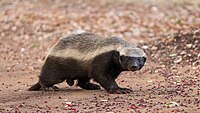
Photo from wikipedia
The subspecies concept is one of the most controversial in Linnean taxonomy. In the past, subspecies were described without a clear conceptual framework, triggering confusion and motivating criticism of the… Click to show full abstract
The subspecies concept is one of the most controversial in Linnean taxonomy. In the past, subspecies were described without a clear conceptual framework, triggering confusion and motivating criticism of the very concept of a subspecies. At present, subspecies are conceived as aggregates of populations that are geographically isolated, are composed of interfertile individuals, and are morphologically diagnosable. The tayra, Eira barbara, was described in 1758 and has had a stable taxonomic history at the species level. However, below the species level, 16 subspecies have been named, with from two to seven subspecies recognized as valid by different authors. None of the subspecies were, however, described within a clear conceptual framework. Using the modern concept of a subspecies, I analyzed subspecies of E. barbara recognized by recent authors. I gathered morphometric data from 155 specimens in mammal collections, georeferenced each specimen, and recorded membership to subspecies assigned by different references and by its location. I gathered climate and geographic data for each location. I analyzed data using Principal Components Analysis (PCA) and analysis of variance (ANOVA). Specimens exhibited sexual dimorphism in size but not in skull shape. I used regression analysis to test for associations between skull shape and size and climate data. Geographic analyses documented that subspecies are not allopatric, violating one of the main properties of the subspecies concept. ANOVA showed significant differences in skull morphology between some pairs of recognized subspecies but not others. However, none of the subspecies segregated in the PCA. Thus, the recognized subspecies could not be diagnosed from morphological data, violating another property of the subspecies concept. Size varied greatly between the sexes using different schemes for recognized subspecies. Climate variables explained between 4% and 6% of size variation for males and females. Skull shape proved not to be geographically variable.
Journal Title: Journal of Mammalogy
Year Published: 2020
Link to full text (if available)
Share on Social Media: Sign Up to like & get
recommendations!